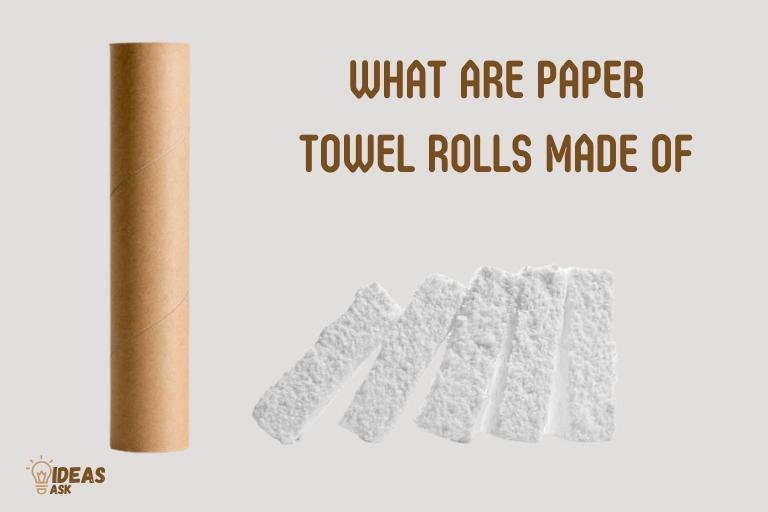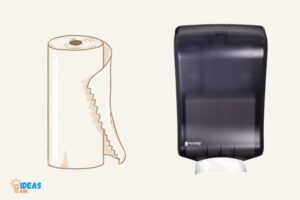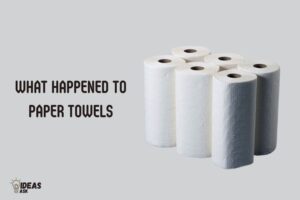What are Paper Towel Rolls Made of? Cellulose Fibers!
Paper towel rolls are primarily made up of cellulose fibers, which are derived from wood pulp.
The pulp is treated with chemicals, heated, and then shaped into the familiar sheets of absorbent paper we know as paper towels. The process of manufacturing paper towel rolls starts with harvesting trees.
The wood from these trees is then transformed into wood pulp, which contains cellulose fibers. These fibers are essential for giving paper towels their absorbency.
Once the pulp is ready, it is treated with chemicals, bleached, heated, and pressed to form thin sheets. These sheets are then embossed for better absorbency, wound onto rolls, and cut into the right size.

Key Takeaway
Raw Materials Used In The Making Of Paper Towels
- Wood pulp – is the primary raw material used in making paper towel. Wood pulp is obtained from trees such as spruce, pine, and fir
- Water – is used as a binder that holds the wood fibers together
- Additives – are added to the wood pulp to enhance the paper’s strength, absorbency, and softness. Common additives include fillers, sizing agents, and wet strength resins
Chemicals Added To Improve The Quality Of Paper Towels
- Bleach – is used to whiten the paper
- Softening agents – are added to make the paper towels soft and gentle to the touch
- Disinfectants – are added to kill bacteria and other germs
Sustainability Of The Materials Used
Manufacturing paper towels requires a lot of resources, and it’s important to consider the sustainability of the materials used.
Here are a few things to keep in mind:
- Using recycled paper – is one way to make paper towels more sustainable
- Selecting paper from responsibly managed forests – ensures that new trees are planted to replace those that were used
- Choosing paper towels that are free of harmful chemicals – reduces the impact on the environment
Paper towels are made from wood pulp, water, and various additives, including bleach, softening agents, and disinfectants. By selecting sustainable materials and reducing the use of harmful chemicals, we can all do our part to make a positive impact on the environment.
The Manufacturing Process Of Paper Towel Rolls
Paper towel rolls are a common household item used for cleaning and wiping up spills. Have you ever wondered what these rolls are made of and how they are manufactured? Let’s take a closer look at the manufacturing process of paper towel rolls.
Pulping Process
The first step in the manufacturing process of paper towel rolls is the pulping process. This involves converting wood chips into pulp using chemicals and high-pressure water. The pulp is then screened to remove any impurities and cleaned to ensure that it is of high quality.
Pressing & Drying
Once the pulp is ready, it is sent to a machine where it is formed into a continuous sheet and pressed to remove any excess water. The sheet is then passed through large heated rollers to dry it out completely.
Coating Process
After the sheet is dried, it is coated with a layer of adhesive, which helps to make it stronger and more absorbent. The adhesive is made up of a combination of chemicals and water, which are applied to the sheet using a spray mechanism.
Winding & Cutting
Once the sheet has been coated, it is wound around a large roll, which can weigh several tons. The roll is then transported to a machine where it is cut into smaller, more manageable rolls. The rolls are typically between 11-12 inches in length and can be up to 6 inches in diameter.
Packaging Process
The final step in the manufacturing process of paper towel rolls is the packaging process. The smaller rolls are packaged into larger boxes, typically containing 6-12 rolls per box. The boxes are then shipped to retailers, where they are sold to consumers.
Paper towel rolls are a convenient and essential item found in most households. The manufacturing process involves the pulping process, pressing & drying, coating process, winding & cutting, and packaging process.
Each step in the process is critical in producing high-quality, absorbent paper towel rolls that consumers have come to rely on.
Environmental Impacts Of Paper Towel Rolls
What are paper towel rolls made of: environmental impacts of paper towel rolls
As consumers, we tend to overlook the environmental cost of our everyday items. One such item is paper towel rolls.
While they are convenient and useful, have you ever wondered about their impact on the environment? Let’s dive in and explore how paper towels contribute to environmental degradation.
Discuss The Impact Of Paper Towel Production On The Environment
The production of paper towels has a range of environmental impacts, including:
- High water usage: Paper towel production requires a lot of water, a natural resource that is scarce in many parts of the world.
- Deforestation: The production of paper towels necessitates the harvesting of millions of trees each year, resulting in deforestation and decreased biodiversity.
- Chemical usage: The process of bleaching and dyeing paper towels requires the use of harsh chemicals that can be damaging to both workers and the ecosystem.
The Effects Of Bleach And Dyes On The Ecosystem
The production of paper towels requires the use of bleach and dyes, which can have lasting and damaging effects on the environment.
Here’s what you need to know:
- Bleaching agents are often chlorine-based, which can have toxic effects on aquatic life and release harmful pollutants into the air.
- Dyes can cause harm to wildlife and plants in the surrounding areas where they are manufactured.
- The amount of energy required to manufacture and transport bleach and dyes is significant, contributing to the overall carbon footprint of paper towel production.
While paper towels are convenient and useful, it is important to consider their significant impact on the environment. By opting for eco-friendly alternatives or reducing overall paper towel usage, we can make a positive impact on the health of our planet.
Alternatives To Traditional Paper Towel Rolls
Paper towels are convenient, but they aren’t very eco-friendly.
If you’re looking for a more sustainable option, consider these alternatives:
- Bamboo towels: Made from sustainable bamboo fibers, these towels are reusable and biodegradable, making them an excellent eco-friendly option.
- Recycled paper towels: Many brands now offer paper towels made from recycled materials, which helps to reduce the number of trees cut down for paper production.
- Microfiber cloths: These cloths are made from tiny fibers that can clean up messes without the need for cleaning products. They’re reusable and can be washed in the dishwasher or washing machine.
- Compostable towels: Some brands now offer paper towels that are fully compostable, meaning they can be added to your compost bin instead of the trash can.
Conclusion
Paper towel rolls are a common household item that most people use daily. They’re typically made from virgin pulp or recycled paper.
During the production process, the paper is chemically treated and bleached to give it a bright white color. Depending on the brand and the type, some paper towels may have additional features like extra absorbency or added strength.
While the environmentally conscious may prefer to use recycled paper towels, it’s essential to note that both virgin and recycled paper towels have their own particular benefits and drawbacks.
Ultimately, it comes down to personal preference. Regardless of which type you choose, paper towel rolls are a convenient and practical item to have around the home.






